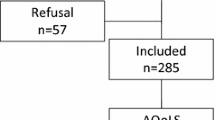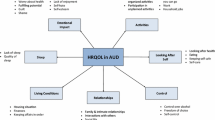Abstract
Alcoholism has the potential to impact on the quality of life (QOL) of an ‘alcoholic,’ their family, and friends in both the short and long term. Consequently, increasing significance has been placed on understanding health issues from the patient’s perspective, evaluating the patient’s subjective experience of his/her symptoms (as well as any treatment), and the impact of these on his/her QOL. The objective of this review was to identify and evaluate the content validity of measures used to assess health-related QOL (HR-QOL) in alcoholism (alcohol abuse and alcohol dependence).
Systematic searches of Scopus (1990–2007) were conducted using terms synonymous with alcoholism combined with terms associated with measuring HR-QOL. A total of 618 abstracts were identified, detailing the use of 16 generic patient-reported outcome measures to assess HR-QOL in alcoholism. Upon further examination of item content, seven measured generic health status and nine assessed generic QOL or life satisfaction (with varying definitional criteria and domain focus).
The SF-36 and EQ-5D, in particular, have been used widely, but were misinterpreted frequently as measures of HR-QOL rather than health status. One alcohol-specific measure was identified: the AlQoL 9, a scale that some have claimed to epitomize alcohol-related QOL. However, the AlQoL 9 was developed by reducing the SF-36 (French version) to the nine items most relevant to alcoholism. The methodology for determining the relevance of the existing items of the SF-36 was comprehensive but the adapted measure does not include assessment of additional concepts (such as sleep and social isolation) of particular importance for alcohol-related QOL.
There is a lack of research and assessment of HR-QOL in alcoholism and alcohol abuse, and our assessment of the content validity of existing measures used to date suggests that many are likely to be inadequate. Given the insufficiencies of generic measures and the limited applicability of the AlQoL 9, there is a need for an alcoholism-specific QOL measure that focuses on the domains that are most salient to people with such problems. Individuals need to be given the opportunity to determine the extent to which their QOL is impaired by alcoholism based upon their own criteria for what constitutes good HR-QOL. Only then will we be able to assess the full impact of alcoholism (and its treatment) on QOL.






Similar content being viewed by others
Notes
Scopus is a search engine that includes journals indexed via MEDLINE (100%), EMBASE (100%), PubMed (100%), PsycINFO (65%), and CINAHL (65%). In addition to its ability to combine searches of various databases, Scopus also offers citations, searches of patent content and the web, as well as ranking and sorting of results to aid navigation.
References
American Psychiatric Association. Diagnostic and statistical manual of mental disorders. 4th ed. Washington, DC: American Psychiatric Association (APA), 1994
World Health Organization. International statistical classification of diseases and related health problems. 10th revision (ICD-10). Version 2007 [online]. Available from URL: http://www.who.int/classifications/apps/icd/icd10online/ [Accessed 2006 Feb 7]
Foster JH, Peters TJ, Marshall EJ. Quality of life measures and outcomes in alcohol-dependent men and women. Alcohol 2000; 22: 45–52
Burge SK, Schneider FD. Alcohol-related problems: recognition and intervention. Am Fam Physician 1999; 59(2): 361–70
Acquadro C, Berzon R, Dubois D, et al. PRO Harmonization Group: incorporating the patient’s perspective into drug development and communication. An ad hoc task force report of the Patient-Reported Outcomes (PRO) Harmonization Group meeting at the Food and Drug Administration. Value Health 2003; 6: 522–31
Foster JH. Quality of life measurement and alcoholism: another arm to nursing practice? Clin Eff Nurs 2006; 9(3): e295–301
Edelman D, Olsen MK, Dudley TK, et al. Impact of diabetes screening on quality of life. Diabetes Care 2002; 25: 1022–6
Tankova T, Dakovska G, Koev D. Education of diabetic patients: a one year experience. Patient Educ Couns 2001; 43: 139–45
Taylor R, Foster B, Kyne-Grzebalski D, et al. Insulin regimens for the non-insulin dependent: impact on diurnal metabolic state and quality of life. Diabet Med 1994; 11: 551–7
Joyce CRB. Requirements for the assessment of individual quality of life. In: Bradley C, editor. Quality of life following renal failure: psychosocial challenges accompanying high technology medicine. Chur: Harwood Academic Publishers, 1994: 43–54
Testa MA, Simonson DC. Assessment of quality of life outcomes. N Engl J Med 1996; 334(13): 835–40
Carr AJ, Gibson B, Robinson PG. Is quality of life determined by expectations or experience? BMJ 2001; 322: 1240–3
US Department of Health and Human Services FDA Center for Drug Evaluation and Research; US Department of Health and Human Services FDA Center for Biologics Evaluation and Research; US Department of Health and Human Services FDA Center for Devices and Radiological Health. Guidance for industry: patient-reported outcome measures. Use in medical product development to support labelling claims: draft guidance. Health Qual Life Outcomes 2006; 4: 79
Foster JH, Peters TJ, Kind P. Quality of life, sleep, mood and alcohol consumption: a complex interaction. Addict Biol 2002; 7: 55–65
Walker J, Bradley C. Assessing the quality of life of adolescents with diabetes: using the SEIQoL, DQOL, patient and diabetes specialist nurse ratings. Pract Diabetes Int 2002; 19(5): 141–4
Smith KW, Larson MJ. Quality of life assessments by adult substance abusers receiving publicly funded treatment in Massachusetts. Am J Drug Alcohol Abuse 2003; 29: 323–35
Foster JH, Powell JE, Marshall EJ, et al. Quality of life in alcohol-dependent subjects: a review. Qual Life Res 1999; 8: 255–61
Malet L, Llorca PM, Beringuier B, et al. AlQoL 9 for measuring quality of life in alcohol dependence. Alcohol Alcohol 2006; 41: 181–7
Jamison JR. The wellness contract: an experiential learning format for preparing students as primary contact health professionals. HERDSA Annual International Conference; 1999 Jul 12–15; Melbourne (VIC)
Gloria L, Cravo M, Camilo ME, et al. Nutritional deficiencies in chronic alcoholics: relation to dietary intake and alcohol consumption. Am J Gastroenterol 1997; 92(3): 485–9
Lemere F, Smith JW. Alcohol-induced sexual impotence. Am J Psychiatry 1973; 130: 212–3
Heaton MB, Mitchell JJ, Paiva M. Amelioration of ethanol-induced neurotoxicity in the neonatal rat central nervous system by antioxidant therapy: alcohol effects on the fetus, brain, liver, and other organ systems. Alcohol Clin Exp Res 2000; 24(4): 512–8
Yokoyama A, Takagi T, Ishii H, et al. Impaired autonomic nervous system in alcoholics assessed by heart rate variation. Alcohol Clin Exp Res 1991; 15(5): 761–5
Mann K, Günther A, Stetter F, et al. Rapid recovery from cognitive deficits in abstinent alcoholics: a controlled test-retest study. Alcohol Alcohol 2007; 34(4): 567–74
Ehikhamenor E, Agwubike EO. The need for blood alcohol concentration (BAC) legislation in Nigeria. Tropical J Pharmaceutical Rese 2004; 3(1): 319–27
Bushman BJ, Cooper HM. Effects of alcohol on human aggression: an integrative research review. Psychol Bull 1990; 107(3): 341–54
Peugh J, Belenko S. Alcohol, drugs and sexual function: a review. J Psychoactive Drugs 2001; 33(3): 223–32
Windle M. Effect of parental drinking on adolescents. Alcohol Health Res World 1996; 20(3): 18–22
Donovan D, Mattson ME, Cisler RA, et al. Quality of life as an outcome measure in alcoholism treatment research. J Stud Alcohol 2005; 15 Suppl.: 119–39
Van Dijk AP, Toet J, Verdurmen JE. The relationship between health-related quality of life and two measures of alcohol consumption. J Stud Alcohol 2004; 65: 241–9
Morgan MY, Landron F, Lehert P. Improvement in quality of life after treatment for alcohol dependence with acamprosate and psychosocial support. Alcohol Clin Exp Res 2004; 28: 64–77
Spitzer RL, Kroenke K, Linzer M, et al. Health-related quality of life in primary care patients with mental disorders. JAMA 1995; 274: 1511–7
The EuroQol Group. EuroQol: a new facility for the measurement of health related quality of life. Health Policy 1990; 16: 199–208
Ware JE, Sherbourne CD. The MOS 36-Item Short-Form Health Survey (SF-36): I. Conceptual framework and item selection. Med Care 1992; 30(6): 473–83
WHOQOL Group. Development of the World Health Organization WHOQOL-BREF quality of life assessment. Psychol Med 1998; 28: 551–8
Sintonen H, Pekurinen M. A fifteen-dimensional measure of health-related quality of life (15D) and its applications. In: Walker SR, Rosser RM, editors. Quality of life assessment: key issues in the 1990s. Dordrecht: Kluwer Academic Publishers, 1993: 185–95
Goldberg D, Williams P. A user’s guide to the General Health Questionnaire. Windsor: NFER-Nelson, 1988
Feeny D, Furlong W, Boyle M, et al. Multi-attribute health status classification systems: Health Utilities Index. Pharmacoeconomics 1995; 7(6): 490–502
Hunt SM, McKenna SP, McEwan J, et al. The Nottingham Health Profile: subjective health status and medical consultations. Social Science Medicine 1981; 15(A): 221–9
Bush JW. General health policy model/Quality of Well-being (QWB) scale. In: Wenger N, Mattson M, Furberg C, et al., editors. Assessment of quality of life in clinical trials of cardiovascular therapies. New York: Le Jacq, 1984
Avis NE, Smith KW, Hambleton RK, et al. Development of the Multidimensional Index of Life Quality. Med Care 1996; 34: 1102–20
Holcomb WR, Beitman BD, Hemme CA, et al. Use of a new outcome scale to determine best practices. Psychiatr Serv 1998; 49(5): 583–95
Chubon RA. Manual for the Life Situation Survey. Columbia (SC): School of Medicine, 1995
Endicott J, Nee J, Harrison W, et al. Quality of Life Enjoyment and Satisfaction Questionnaire: a new measure. Psychopharmacol Bull 1993; 29(2): 321–6
Ferrans C, Powers M. Psychometric assessment of the Quality of Life Index. Res Nurs Health 1992; 15: 29–38
Frisch MB, Cornell J, Villanueva M, et al. Clinical validation of the Quality of Life Inventory: a measure of life satisfaction for use in treatment planning and outcome assessment. Psychol Assess 1992; 4: 92–101
Diener E, Emmons RA, Larsen RJ, et al. The Satisfaction with Life Scale. J Pers Assess 1985; 49: 71–5
McGee HM, O’Boyle CA, Hickey A, et al. Assessing the quality of life of the individual: the SEIQoL with a healthy and a gastroenterology unit population. Psychol Med 1991; 21(3): 749–59
Fayers PM, Machin D. Quality of life: assessment, analysis, and interpretation. New York: John Wiley, 2000
Günther O, Roick C, Angermeyer MC, et al. The EQ-5D in alcohol dependent patients: relationships among health-related quality of life, psychopathology and social functioning. Drug Alcohol Depend 2007; 86(2-3): 253–64
Longabaugh R, Mattson R, Connors G, et al. Quality of life as an outcome variable in alcoholism treatment research. J Stud Alcohol 1994; 55 Suppl.: 119–29
Acknowledgments
No sources of funding were used to assist in the preparation of this review. The authors have no conflicts of interest that are directly relevant to the content of this review.
Author information
Authors and Affiliations
Corresponding author
Rights and permissions
About this article
Cite this article
Reaney, M.D., Martin, C. & Speight, J. Understanding and Assessing the Impact of Alcoholism on Quality of Life. Patient-Patient-Centered-Outcome-Res 1, 151–163 (2008). https://doi.org/10.2165/1312067-200801030-00002
Published:
Issue Date:
DOI: https://doi.org/10.2165/1312067-200801030-00002




